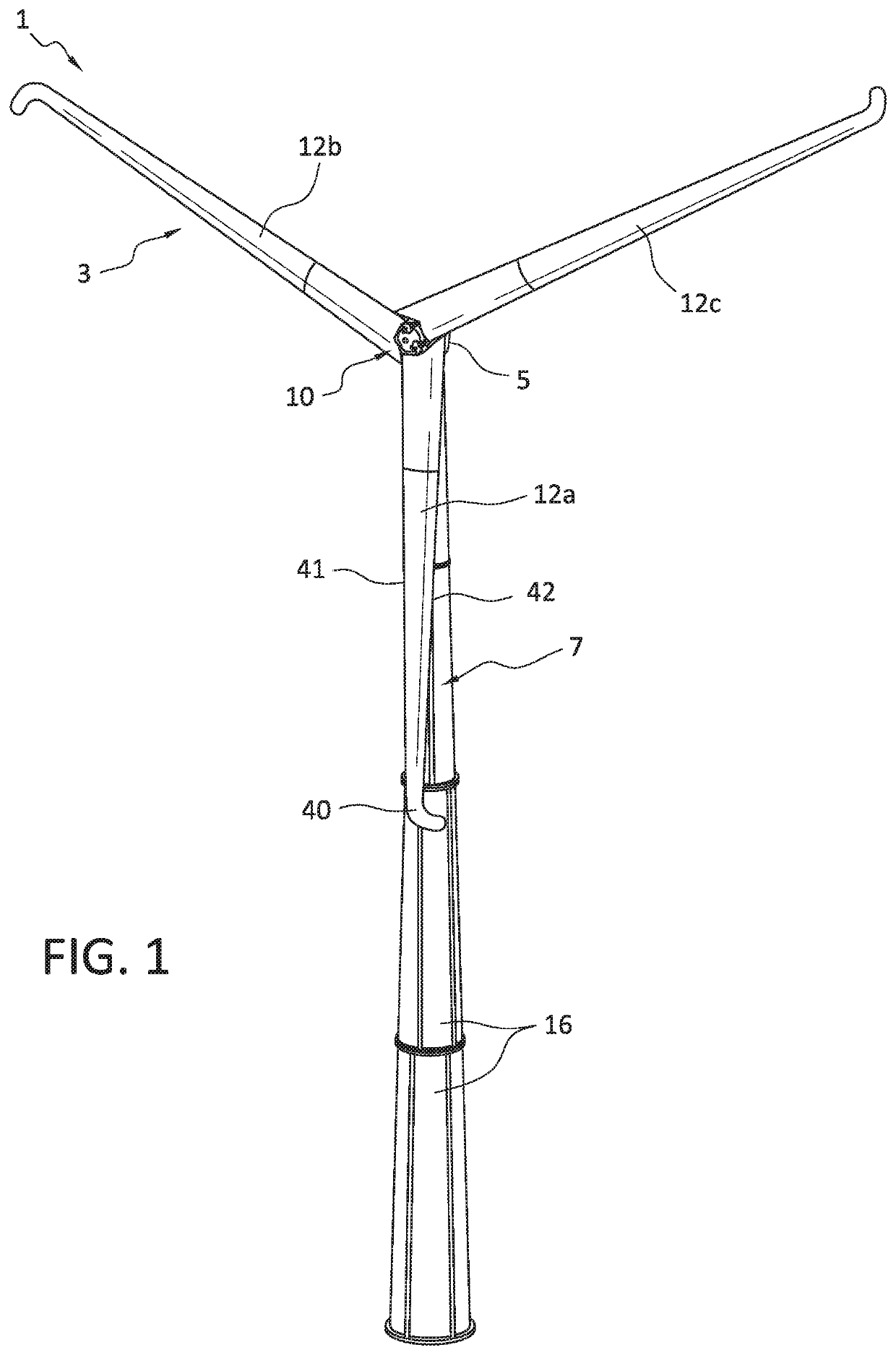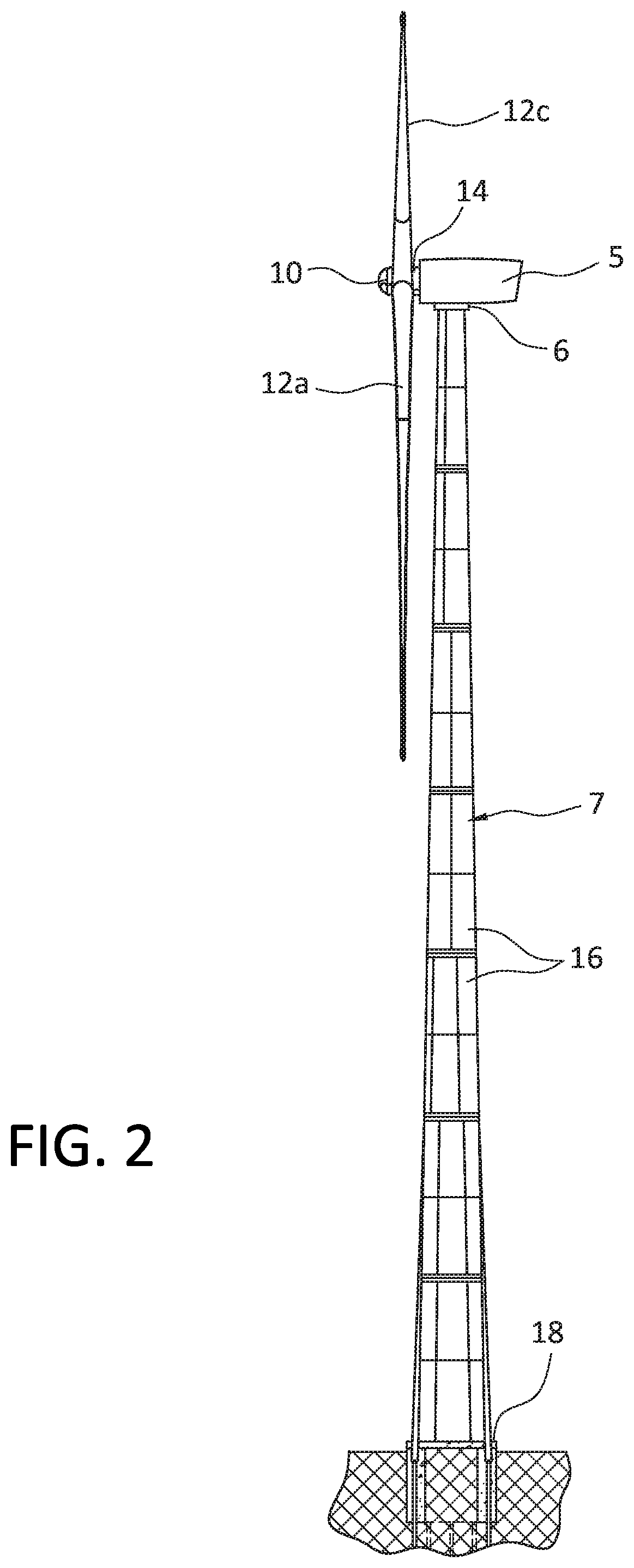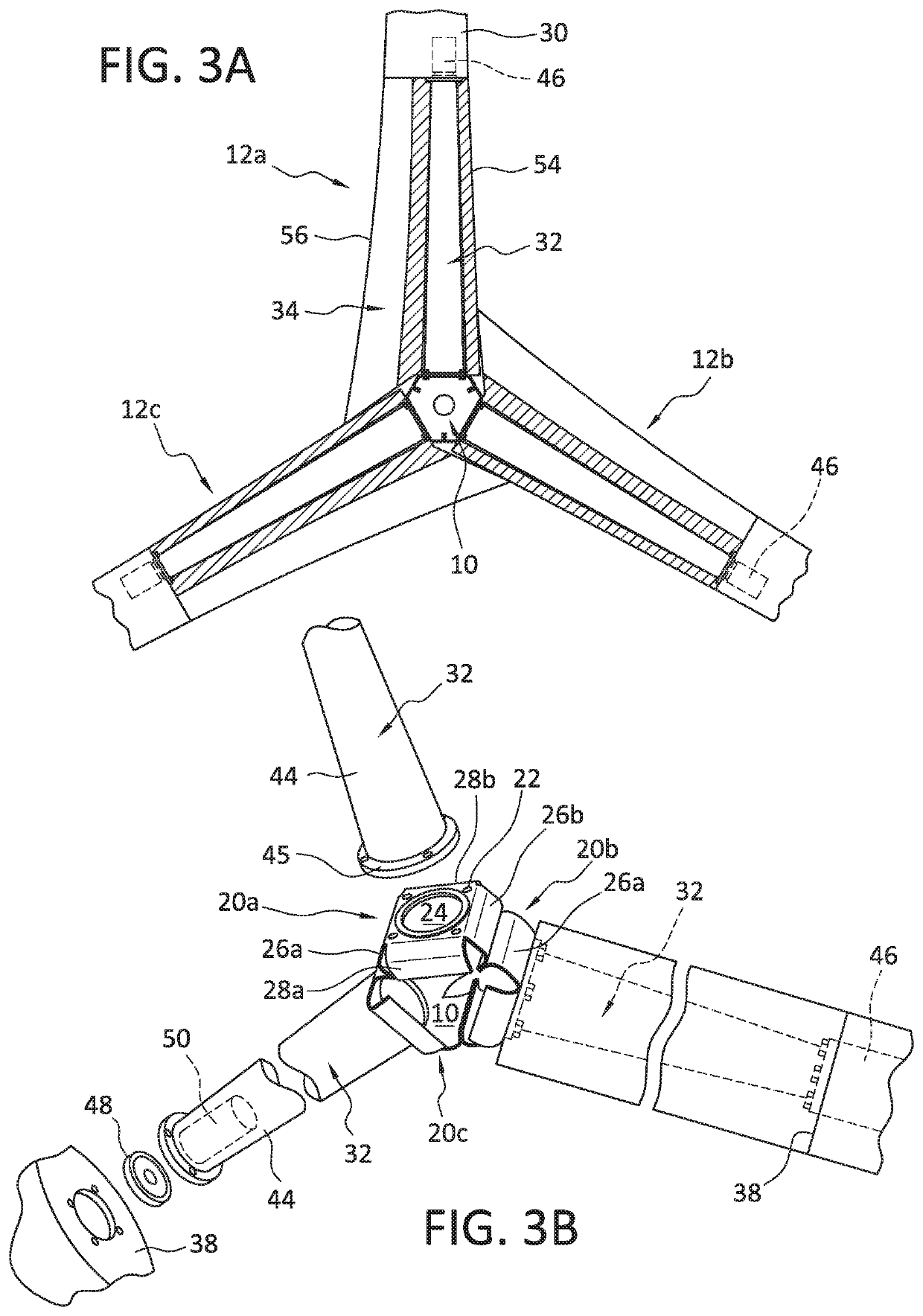[0007]The relatively shorter and wider aerodynamic blades result in a rotor having a specific power of between about 0.25 and 0.29, a specific power rating of between about 240 and 260 watts / m2, and a solidity of between about 5% and 6%. Each of the blades preferably includes an aerodynamic surface over its entire length from a proximal end that is mounted on the modular hub to its distal end. In a preferred embodiment, each blade includes a blade portion having a length that terminates in the blade tip; a blade root connected between the blade portion, and the hub, and an aerodynamic fairing that covers the length of the blade root such that the entire length of the blade includes an aerodynamic, energy-generating surface. The tip end of each blade may include a rearward blade sweep to increase the energy-capturing area The blade root is preferably formed from a material such as rolled steel that is less flexible than the material forming the blade portion to prevent the higher moment forces applied to the relatively shorter and wider blades during high-wind conditions from bending the blades to the extent that they collide with the support tower. The length of the blade root is between about 20% and 30% of the over-all length of the blade so that the stiffening that the blade root imparts to the overall blade is substantial. The length of each of the aerodynamic blades is preferably no more than about 65 meters to facilitate the transportation and assembly of the wind turbine generator. The tip end of each blade may include a rearward blade sweep to increase the energy-capturing area without extending the length of the blade. Surprisingly, the applicant has observed that such a wider blade is substantially better in converting low winds having speeds of less than 7.5 m / s into electrical power than conventional, relatively longer and thinner blades, which in turn results in a higher-than-expected energy output.
[0009]The use of a plate-type modular hub in combination with the stiff blade roots advantageously overcomes the problems associated with the use of the relatively wider blades used in the wind turbine of the invention. While the wider blades produce higher moment forces at the hub than conventional, narrower blades of the same length, the bends in the plates forming the hub sections act like corrugations that more strongly resist the resulting flexing of the blades toward the support tower of the wind turbine generator than the partial spherical-shell of steel used in conventional hub designs. These features, in combination with the stiffening of the blades of the invention through the use of a steel blade root that is between 20% and 30% of the overall length of the blade, prevent the blades from flexing to the point of colliding with the support tower even under sustained gusts of abnormally high winds.
[0010]The wind turbine generator may further comprise a nacelle including a support plate, and a gear train to an input shaft of a generator. A drive shaft connected between the hub and an input shaft of the gear train transmits the torque generated by the rotor to the gear train and generator. Preferably, the drive shaft is rotatably supported by a pair of spaced-apart bearings mounted on the support plate that are configured to isolate the input shaft of the gear train from bending forces applied to the distal end of the drive shaft by the plurality of aerodynamic blades. Additionally, the generator housed within the nacelle is preferably a high density, permanent magnet generator as such generators more efficiently convert torque into electrical power at the lower rotational speeds associated with low to moderate winds. This characteristic of a permanent magnet generator also allows the use of a simpler, planetary gear type gear train having a gear ratio on the order of 1:10 which is more reliable and robust and which requires less maintenance than the 1:100 gear ratio drive trains used in most prior art wind turbine generators.
[0011]The support tower of the wind turbine generator is preferably a low-weight, modular plate-type support tower. Additionally, the ratio of the diameter d of the yaw bearing that defines the diameter of the top end of the support tower and the diameter D of the bottom end of the support tower just above the foundation is preferably between about 1.7 to 2.1. By contrast, in prior art support towers, this ratio is no more than about 1.37. Such proportioning of the upper and lower diameters d and D lowers the pressure that the inventive wind turbine generator 1 applies to the foundation by about 50%, since the weight of the wind turbine generator is distributed over twice the area of a conventional wind turbine generator. The use of a lower weight modular, plate-type support tower lowers the overall weight of the support tower typically by about 50,000 pounds, such that the pressure applied by the wind turbine generator to the foundation is reduced by an additional 16%. The resultant lower pressure not only allows the thickness of the foundation to be reduced 60% to 66%, but also allows relatively low-cost, conventional concrete to be used instead of high-cost, high-pressure rated concrete. The substantially thinner foundation also substantially reduces the over-all amount of concrete needed to construct the foundation. This not only reduces the labor and material costs of construction, but also minimizes the amount of water runoff associated with the foundation, as the substantially smaller foundation allows more of the surrounding terrain to maintain its water absorbency. All of these factors are particularly important for the wind turbine generator of the invention, which will likely be constructed on ridges or other high terrain in order to gain exposure to the highest winds in the low-to-moderate wind areas where these turbines are to be built.
[0012]Finally, none of the power conditioning components of the wind turbine generator of the invention are located within the support tower. Instead, these components are located in a separate building outside of the wind turbine generator. Such a design advantageously removes the sensitive power conditioning equipment that converts the DC current generated by the permanent magnet generator into usable AC current from the mechanical shocks and vibration present within the support tower, thereby reducing the need for maintenance and prolonging the life of this equipment.
 Login to View More
Login to View More  Login to View More
Login to View More 


